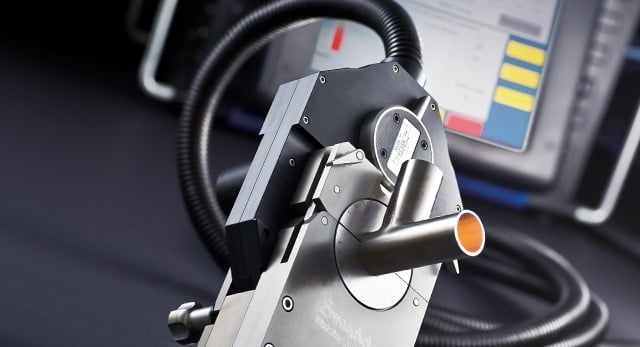Start your in-demand career as an orbital welder by registering for Swagelok’s five-day intense orbital welding training in Edmonton, Alberta.
 Orbital welding is highly desirable for joining tubing and piping tubes and pipes using the TIG (Tungsten Inert Gas) process. It derives its name from the core process involving 360° rotation of the arc around the workpiece. The best part of orbital welding is that you can join nearly any metal and even dissimilar alloys.
Orbital welding is highly desirable for joining tubing and piping tubes and pipes using the TIG (Tungsten Inert Gas) process. It derives its name from the core process involving 360° rotation of the arc around the workpiece. The best part of orbital welding is that you can join nearly any metal and even dissimilar alloys.
The first application of orbital welding dates back to the 1960s when North American Aviation engineer Rod Rohrberg suggested it as the only solution to curb fuel leaks in NASA’s X-15 hypersonic research program that led the foundation for Mercury, Gemini, and Apollo spaceflight programs. Now, orbital welding is at the design forefront of any critical fluid system—one of the reasons behind industries signing up for orbital welding training in Edmonton and beyond.
Orbital welding has a number of advantages over manual welding for which it is highly sought-after for various industrial applications. First, it ensures that approved weld sequences are reliably repeated to save time and increase productivity. Second, with a well-customized weld program in action, each weld cycle yields the same quality without any deviation or defect. Third, orbital welding can be executed under a restricted environment conditioned with limited working space, lack of visibility, or possible radiation exposure to the operator. Moreover, it takes very little training, compared to manual welding, to attain the desired skill levels to obtain excellent results.
That said, industries can save expenses on certified personnel and improve the skills of their existing operators by enrolling them in advanced orbital welding training in Edmonton.
The best part of modern orbital equipment is that you get complete traceability of weld protocol through acquisition, storage, and analysis of real-time data for superior quality management—which falls under the scope of different industries.
Below, the table shows the need for weld quality for different industries to overcome challenges during the production process.
| Industry | Challenge | Issue | Solution |
| Food & Beverages | Cleanliness and hygiene | Bacteria growth under loose joints | Full penetration of welded joints |
| Aerospace | Maintain high-pressure system | Welding of thousands of small, thin-walled tubes | Uniform and controlled welds as per required parameters |
| Pharma | Safe supply of clean steam and injection water | Oxidation and corrosion of joints leading to quality degradation | Extended corrosion resistance of welds |
| Semiconductor manufacturing | Passing ultra-pure process gas through electro-polished stainless tubes | Contamination of the gas through moisture, oxygen, or any foreign particles | Uniform welds, full penetration on the ID |
| Chemical | To increase the service life of installations | Faulty welds in equipment cause corrosion and decrease service life | To carry out several thousands of faultless welds to ensure expected results |
| Nuclear plants | To ensure high pressure and temperature with zero leak | Constant traceability of welding procedures and the weld quality | Online data acquisition of weld data for constant surveillance |
The table identifies orbital welding as an ideal investment to achieve required weld quality. However, it must be performed by knowledgeable personnel, equipped to overcome possible challenges during the welding process.
 Orbital welding comes with a number of challenges that require prior training or related work experience to overcome successfully. The list of possible challenges includes, but not limited to:
Orbital welding comes with a number of challenges that require prior training or related work experience to overcome successfully. The list of possible challenges includes, but not limited to:
A typical position of the workpiece is very important during orbital welding. The welder has to be well aware of the Angle of Inclination and Rotation of Face as per ASME Section IX and EN ISO 6947 to ascertain the actual welding position.
In most cases, orbital welding involves alteration of the weld position and the thermal state of the workpiece to control the bath of molten metal during each cycle. However, it can be easily achieved using a pulsed weld current.
Orbital welding can be performed using both AC (Alternating Current) and DC (Direct Current). While the former is recommended for welding aluminum and its alloys, the latter is used to weld almost any type of material. However, the operator must be fully aware of the ideal electrode-power polarity (positive or negative) connection to heat up the workpiece with greater efficiency.
An ideal shielding gas offers good arc striking and stabilization characteristics. However, its purity level must match with the desired level to weld delicate materials with ease. Also, the welder must know how to increase its weld energy to achieve better penetration and faster welding speeds.
Similarly, backing gases like argon, nitrogen, and hydrogen are also recommended to avoid oxidation of the inner hot metal of the root before, during, or after the orbital welding. However, depending on the base metal, one or a mixture of two backing gases can be used.
Orbital welding gives manufacturers the edge they need. However, for the operators, it comes with an aim to produce consistent results with every orbital weld. It is a challenge for novice welders and thus demands proper training to improve efficiency and productivity.
Edmonton Valve & Fitting offers a five-day intense orbital welding training program for operators looking forward to improving their skills to make successful welds under ASME qualifications. Both welders without previous orbital welding experience and experienced welders requiring a refresher course can join this training program.
The participants will complete the Swagelok M200 Orbital Welding and ASME IX Certification course for orbital welding under instructors with Certified Weld Educator (CWE) and Certified Weld Inspector (CWI) qualifications. By the end of the course, the participants should be able to achieve the required speed and efficiency at orbital welding using best practices followed by industry experts.

Lorem ipsum dolor sit amet, consectetur adipiscing elit. Suspendisse tempor nisi ut vehicula commodo.
Learn More →
Lorem ipsum dolor sit amet, consectetur adipiscing elit. Suspendisse tempor nisi ut vehicula commodo.
Learn More →
Lorem ipsum dolor sit amet, consectetur adipiscing elit. Suspendisse tempor nisi ut vehicula commodo.
Learn More →
Lorem ipsum dolor sit amet, consectetur adipiscing elit. Suspendisse tempor nisi ut vehicula commodo.
Learn More →
Lorem ipsum dolor sit amet, consectetur adipiscing elit. Suspendisse tempor nisi ut vehicula commodo.
Learn More →
Lorem ipsum dolor sit amet, consectetur adipiscing elit. Suspendisse tempor nisi ut vehicula commodo.
Learn More →
Lorem ipsum dolor sit amet, consectetur adipiscing elit. Suspendisse tempor nisi ut vehicula commodo.
Learn More →
Lorem ipsum dolor sit amet, consectetur adipiscing elit. Suspendisse tempor nisi ut vehicula commodo.
Learn More →
Lorem ipsum dolor sit amet, consectetur adipiscing elit. Suspendisse tempor nisi ut vehicula commodo.
Learn More →Swagelok is a $2B developer of industrial fluid system products and services. Swagelok Edmonton is an authorized Swagelok Sales and Service Centre serving Canadian companies in clean energy, chemical, oil and gas, and other industries. Proud member of the Canadian Council for Aboriginal Business.
Tel: 780-437-0640.
Swagelok Edmonton values your privacy. This website uses cookies to enhance user experience and analyze performance and traffic. Our policies are posted here.
Login/Register | Privacy | Safe Selection | Centre Locator | Sitemap | Legal
© 2012-2024 Edmonton Valve & Fitting Inc.